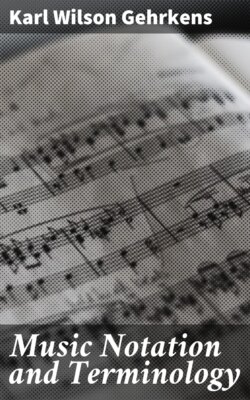Читать книгу Music Notation and Terminology - Karl Wilson Gehrkens - Страница 9
На сайте Литреса книга снята с продажи.
Symbols of Music Defined (Continued)
ОглавлениеTable of Contents
21. The natural[8] (sometimes called cancel) annuls the effect of previous sharps, flats, double-sharps, and double-flats, within the measure in which it occurs. After a double-sharp or double-flat the combination of a natural with a sharp, or a natural with a flat is often found: in this case only one sharp or flat is annulled. (Sometimes also the single sharp or flat will be found by itself, cancelling the double-sharp or double-flat). The natural is often used when a composition changes key, as in Fig. 11, where a change from E to G is shown.
22. The group of sharps or flats (or absence of them) at the beginning of a staff partially indicates the key in which the composition is written. They are called collectively the key-signature.
23. The same key-signature may stand for either one of two keys, the major key, or its relative minor, hence in order to determine in what key a melody is one must note whether the tones are grouped about the major tonic DO or the minor tonic LA. In a harmonized composition it is almost always possible to determine the key by referring to the last bass note; if the final chord is clearly the DO chord the composition is in the major key, but if this final chord is clearly the LA chord then it is almost certain that the entire composition is in the minor key. Thus if a final chord appears as that in Fig. 12 the composition is clearly in G major, while if it appears as in Fig. 13, it is just as surely in E minor.
[Listen]
24. Sharps, flats, naturals, double-sharps and double-flats, occurring in the course of the composition (i.e., after the key signature) are called accidentals, whether they actually cause a staff degree to represent a different pitch as in Fig. 14 or simply make clear a notation about which there might otherwise be some doubt as in Fig. 15, measure two. The effect of such accidentals terminates at the bar.
[Listen]
25. In the case of a tie across a bar an accidental remains in force until the combined value of the tied notes expires. In Fig. 16 first measure, third beat, an accidental sharp makes the third space represent the pitch C sharp. By virtue of the tie across the bar the third space continues to represent C sharp thru the first beat of the second measure, but for the remainder of the measure the third space will represent C unless the sharp is repeated as in Fig. 17.
[Listen]
26. The following rules for making staff degrees represent pitches different from those of the diatonic scale will be found useful by the beginner in the study of music notation. These rules are quoted from "The Worcester Musical Manual," by Charles I. Rice.
